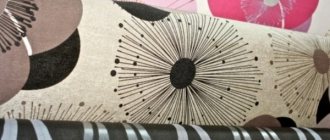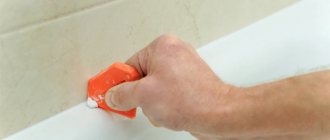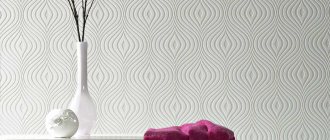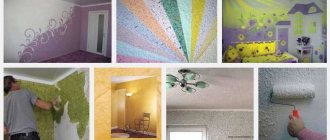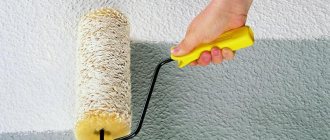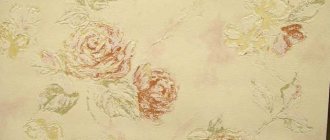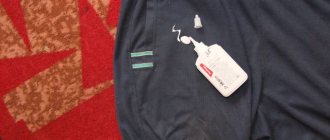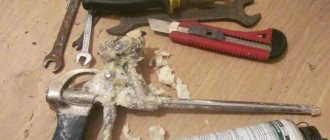It is the wallpaper on the walls that creates the first impression of the living space. That’s why homeowners carefully select the pattern and texture of the wall covering before renovating. With wallpaper pasted, the room is filled with warmth and homeliness. However, like any living space, rooms in apartments and houses are prone to contamination. This also applies to wallpaper. One of the residents may touch the wall with a dirty shoe, drip wine or coffee, and small children may even turn the wall into an artistic canvas. Therefore, any housewife sooner or later will have to think about how to wash wallpaper from dirt stains, and in the case of children, how to wash paint, plasticine and possibly even brilliant green from the wallpaper.
What wallpaper can be cleaned?
Before you begin to influence the coating in one way or another, you need to make sure that this type of wallpaper can be washed at all. Otherwise, instead of a small stroke from the pen, we will get a large white spot.
The necessary information is contained on the label located inside each roll. Make it a rule for the future that after each repair, save a small piece of new wallpaper, and attach a label to it using a stapler. You need to pay attention to the icons with wavy stripes, which indicate the degree of resistance of the surface to cleaning:
- One wavy stripe means that the surface can be wiped without pressure and without using detergents with a soft, damp cloth;
- Two wavy lines indicate the surface’s resistance to the effects of a soft sponge dipped in soapy water;
- Three stripes mean the possibility of long-term washing with a well-moistened sponge;
- One wavy line, a straight stripe and a ridge mean that the surface of the wallpaper can withstand wet cleaning with a brush or a vacuum cleaner;
- Three wavy lines, one straight and a comb. This marking is applied to the label of the most resistant wallpaper. They can even be rubbed with a brush and soapy water until foam forms.
We recommend that you strictly adhere to these recommendations. You also need to understand that even the most durable surfaces, if rubbed for a long time in the same place, can change color or lose their glossy shine.
Types of wallpaper and causes of contamination
Types of wallpaper
Typically, washable wallpaper is applied in rooms with the greatest likelihood of contamination - in the hallway, kitchen and children's room. It is important to remember that not all types of wallpaper can be washed using chemicals and hard brushes. Some of them only need to be lightly wiped with a damp sponge.
Therefore, when choosing wallpaper, you must pay attention to the markings indicated on the label:
- One wave is moisture-resistant wallpaper that cannot be washed with special products. To avoid damaging the design, just wipe them carefully with a damp sponge or rag.
- Two are washable wallpapers that can be cleaned with water and any detergent. However, you should not rub them too hard and use a brush to wash them.
- Three – wallpaper with a durable, moisture-repellent coating that will not be harmed by any household chemicals.
- One wave and a brush - wallpaper that can be cleaned with a washing vacuum cleaner or brush.
- Three waves and a brush - wallpaper that is not subject to deformation when using any household chemicals and brushes of any hardness.
The most popular types of washable wallpaper include:
- liquid;
- fabric;
- non-woven;
- silk-screened;
- vinyl (foamed, smooth, thick).
They can become dirty for a variety of reasons. The most common stains include:
- greasy coating;
- dust;
- traces of dirty hands, outerwear, shoes;
- soot;
- stains from watercolor paints, pencils, felt-tip pens.
The method of cleaning the coating from dirt is selected in accordance with the type of wallpaper and types of stains.
Cleaning paper wallpaper
This type of wallpaper is the thinnest and most delicate, therefore the most difficult to maintain. The paper surface quickly becomes wet under the influence of a damp sponge or rag, so in this case it is permissible to use only dry cleaning. Also, paper is easily scratched, so the use of hard sponges is also not recommended.
- No. 1. If there is a dried mark of something , you can try to exfoliate the dirt using an old toothbrush with soft bristles. It is possible that even if a certain amount of the dried substance can be wiped off, a spot of a distinctive color will remain on the surface. If it is on an invisible part of the wall, you can try to remove the residue with a barely damp soft sponge or damp cotton pad, simply blotting the surface. After this, you immediately need to remove any remaining moisture by placing a paper towel on the spot. We warn you that attempting to rub a wet area will inevitably cause the paper to simply roll off;
- №2. Stain from a pencil or colored pencil You can try to eliminate it using a stationery eraser. But you need to use only its soft side. Under no circumstances should you wet the eraser for greater effect or press too hard, otherwise the paper will begin to roll and the area being treated will end up being much lighter than the main tone;
- No. 3. To combat greasy stains, use an iron. Place a clean white sheet of paper over the stain and “iron” the problem area. The steaming mode must be turned off. Also, do not use maximum temperatures, otherwise the paper can easily ignite. If the wallpaper is many years old and low-quality glue was used when gluing it, the surface may change shade after ironing. Try to carry out the procedure on an invisible section of the wall first;
- No. 4. also remove greasy stains with bread crumbs. A small piece of bread should be heated in the microwave, but not allowed to dry out. Use a warm crumb to roll out the fatty area, pressing lightly. It may be necessary to replace the bread with new bread several times before the stain disappears completely;
- No. 5. You can also pour a little crushed chalk or tooth powder onto a soft cloth, apply it to the greasy area and iron it over the top with a warm iron;
- №6. If there is a wallpaper many small greasy spots, you can iron the entire surface through a paper napkin with a warm iron. At the same time, you should not deliberately linger in one place; it is better to move the iron smoothly and slowly;
- No. 7. Marks from a ballpoint pen are very difficult to remove from paper wallpaper. It's the same as erasing a pen from a notebook sheet, only in the latter case the paper is thicker. If the depth of pressure from the pen is shallow and the stain is quite fresh, it is best to use an eraser. You can’t rub too hard, and you can’t cover a large area. Try to work specifically on the ink mark, otherwise the wallpaper around you will quickly lighten and the stain will remain in place;
- №8. If the eraser does not help, soak a cotton swab in a small amount of acetone or alcohol and gently blot the problem area. There is a possibility that the solvent will begin to corrode not only the pen mark, but also the pigment of the wallpaper itself, or an ink stain will form as the ink dissolves. Therefore, sometimes it is better to avoid cleaning altogether.
Washing methods
There are quite a few ways to wash wallpaper-covered walls, each of them depends on the composition of the stain present. Let's present the most common ones that you might encounter on a daily basis.
See also
How to clean a chimney (chimney in a private house) from soot with your own hands
From pollution
Usually, dirt dries out after it gets on the decorative coating, so the first step is to remove it with a brush, broom, or vacuum cleaner. Wet cleaning is started if, after sweeping, a stubborn stain remains.
- Apply a water-soda solution, let it dry, and then sweep away the residue.
- You can remove dirt and dust using talcum powder; how to do this is described above.
Such techniques are applied to washable wallpaper; paper wallpaper will only have to be wiped off.
From fat and plaque
It is easy to remove grease from the walls if it is fresh and has not had time to saturate the structure of the coating. Use against fat:
- Special household chemicals with the indication “anti-grease” for kitchen coatings, for example, Morning Fresh or Fairy.
- The fat will absorb the bread crumb.
- The best way to dissolve the oldest greasy stains on wallpaper is a combination of alcohol and gasoline.
- The same can be done with acetone.
- Starch, soda and baby powder absorb grease residue from wallpaper well. Chalk can be used as a substitute.
- And toilet paper will best remove and absorb grease if you iron it on top with a warm iron.
Various plaque can be eliminated by any of the means described above: alcohol, Mr. Muscle, ammonia.
From stains
Stains on wallpaper can be of any origin - organic and synthetic. Anything can be removed with soapy water or gasoline. When using gasoline, make sure that there is no fire nearby, and after the procedure, be sure to ventilate the room.
From ink and paint
If there are small children in the house, it is impossible to avoid caricatures on the walls. Therefore, you should stock up on the skills in advance to remove traces of felt-tip pens, ballpoint pens, paints, markers, and plasticine. The following tools will help:
- For white wallpaper, use any bleaching agent (Vanish, Belizna, Bos). Clean only the area under the design with clean objects and clean hands.
- Another way to remove ink is with a solution of citric or oxalic acid. You can treat with half a fresh lemon.
- An interesting option is to use a boiled egg. When cooled, apply it to the stain and leave for 5 minutes, then wipe with a dry, clean cloth.
A fresh design can be removed with a melamine sponge or eraser.
From tobacco smoke
The listed products will help remove not only ingrained cigarette smoke, but also soot and soot.
- Citric acid can remove yellowness from smoke, soot and soot.
- Another substance that will not only remove dirt, but also neutralize odor is 9% vinegar.
Such techniques are used not only on wall coverings, but also on ceiling wallpaper, where soot accumulates most.
From mold
The mold stain remover must contain an aggressive substance that can kill the fungus. Vinegar or lemon juice can serve as such a preparation. It is applied for 15-20 minutes to the wallpaper. During this time, mold spores die, and they penetrate very deeply, even into plaster and concrete.
From food products
If tea, coffee, fruit juice or other food products are accidentally dropped on the wallpaper, the marks can be removed with a soap solution. First, the dirty surface is moistened with the solution, and then wiped with a clean cloth and water.
From brilliant green
Zelenka is easy to clean with hydrochloric acid. How to do this is described above.
From dust
Dust can be easily swept away with a feather duster, soft brush, broom and vacuum cleaner. But there is dust that sticks to soot or mixes with fat, then more radical methods are used that break down organic matter: soda, starch, bread and dishwashing detergents.
How to clean non-woven and vinyl wallpaper
The surface of these types of wallpaper is much easier to clean, because in this case you can use a damp sponge.
- No. 9. Often the surface of vinyl wallpaper specifically designed for use in the kitchen is washable. But this does not mean that you can generously wet the surface. To begin, try treating any stain with a soft sponge soaked in clean, warm water and wrung out well;
- №10. You can also use highly carbonated water to clean such wallpaper. The high oxygen content in it will help dissolve greasy stains;
- №11. If there is a build-up around a switch or socket greasy greasy stains, you can dilute liquid dishwashing detergent in a small amount of water, foam it well and lightly rub the marks with foam applied to a sponge;
- No. 12. To remove marks from felt-tip pens, you first need to decide on their composition. Water-based markers dissolve with regular warm water; alcohol-based dyes will not be able to resist the gentle action of alcohol. The main thing is not to rub;
- No. 13. Ink marks can be removed with a melamine sponge. But the sponge must be new, and the stain must not be very old;
- No. 14. remove pen marks from a non-woven surface using lemon juice. But under no circumstances replace it with citric acid, as its concentration is much higher. With this effect, the stain will go away along with the area of the decorative surface. A cotton pad soaked in juice should be applied to the stain and held for 5 minutes. Then remove the remaining juice with warm water. If the method does not help, we do not recommend using it again. Wallpaper may change color.
Professional cleaning compounds
If you look for wallpaper cleaner on store shelves, you will most likely find something like this. In order not to waste their time, housewives use the most common means for everyone, intended for kitchen surfaces or cleaning furniture.
Pronto
Furniture cleaner will do an excellent job of removing stains on wallpaper. It is sold in a spray bottle, which makes it easier to work with. Pronto will eliminate dust and fingerprints and children's hands.
Vanish
This product is used to clean soft surfaces: carpets, furniture. It is added to water and stirred until a thick foam forms. The foam will wash away any dirt on the wallpaper, including those that cannot be washed at all.
Freshbubble
The spray for cleaning kitchen surfaces from grease and carbon deposits is also used for washing wallpaper. By analogy, you can use a detergent for all types of surfaces - Ecover. Both products are equipped with spray nozzles, which makes work easier. It is enough to apply the substance and then wash off the traces with a damp cloth.
Textile wallpaper or paintable wallpaper
Textile wallpaper should never be wet, much less rubbed. Their decorative layer is very delicate and requires similar treatment.
- No. 15. From fabric wallpaper you can only remove a dried, not greasy stain . It should be gently brushed with a soft toothbrush. In all other cases, it is better to refuse cleaning. Metallized inserts are especially delicate;
- №16. When choosing methods for removing stains from painted wallpaper, be sure to take into account what coloring composition was used. In apartments, water-based paints are most often used. Under no circumstances should such surfaces be rubbed with wet sponges, otherwise the paint will dissolve;
- No. 17. If paint on a different base was used, then to remove any stain it is best to use a regular soap solution, but not a very concentrated one.
Dark spots
If they appear, in no case should you neglect them. Dark areas indicate the appearance of mold that is hazardous to human health. The process of getting rid of mold is long and labor-intensive and requires complete removal of the coating. The humidity in the room must be brought back to normal, as well as ensure good ventilation and ventilate the room more often.
To get rid of mold you need:
- remove old wallpaper and clean the walls with sandpaper or a stiff brush with metal bristles;
- wash the walls from dust and, after drying, treat with an antifungal agent;
- brush again, wash the walls with water;
- When the walls are completely dry, you can apply the primer in several layers. Then glue new ones.
Important! All of the above must be done in a well-ventilated area; it is better to wear a respirator to protect the respiratory system.
Questionable methods
There are many more methods on the Internet that housewives recommend using. However, on various forums there are both negative reviews after using such tips, and mentions that they do not have the desired effect.
Before using the methods listed below, we advise you to try them either on remnants of wallpaper, if any, or on invisible areas of the wall.
Almost all methods relate to removing marks from a ballpoint or gel pen and are recommended only for vinyl wallpaper. Be sure to wear rubber gloves before working.
- №18. Potassium permanganate + vinegar. Add potassium permanganate to a small amount of 7% vinegar to make the solution a deep purple color. Dampen a cotton pad or cotton swab and apply to the area. After this, wipe the surface with a clean pad soaked in hydrogen peroxide. If the strokes from the pen are thin and single, then it is better to use a brush to reduce the area of exposure of the solution to the clean surface;
- №19. Dissolve 10 g of oxalic acid in 100 ml of clean water. Soak a sponge or cotton pad in the solution and wipe the outlined area;
- №20. Dissolve 1 tsp in 200 ml of water. table salt and 1 tbsp. of hydrochloric acid. Using a cotton swab, apply the product to the stain, and then wash off the residue with a damp soft cloth;
- №21. Dissolve 2 tsp in 100 ml of water. any detergent. Treat the area with the resulting soap solution until the ink disappears completely. To remove marks or stains, wipe the surface with a damp, clean cloth;
- №22. Dissolve 20 ml of white in 100 ml of warm water. This method is only used for white or very light wallpaper. Soak a sponge in the solution and treat the stain;
- №23. It is also recommended to remove stains on white surfaces using whitening toothpaste. A small amount of paste is applied to a soft toothbrush and the mark from the handle is treated. After this, let the paste dry and wipe off the residue with a dry cloth;
- №24. Soak a cotton pad in acetone-free nail polish remover and rub the ink. This method can only remove fresh marks from a ballpoint pen, felt-tip pen or marker;
- №25. To clean the surface of waterproof wallpaper, you can use a special ready-made product “Arenas exet 2”. They treat the dirt with it and leave it for 10 minutes, after which they wipe it with a dry cloth;
- №26. A slurry is prepared from 550 ml of warm water and 50 g of starch, which is applied to the ink and left until completely dry. Then remove the residue with a dry cloth;
- №27. A small amount of regular shaving foam is applied to the stain and allowed to dry, after which the surface is wiped with a dry cloth;
- №28. The yolk of a boiled chicken egg is applied to the mark of a ballpoint pen and wait until the product absorbs the ink;
- №29. Use a brush dipped in warm milk to treat the stain and let the milk dry completely. The spots should lighten and then disappear completely;
- №30. Grate a small amount of laundry soap and prepare a paste from it. Apply it to the surface of the wallpaper and wait until it dries completely. Repeat as necessary;
- №31. Using wet wipes, you can try to wipe off not only the pen mark, but also other stains.
Rules for cleaning and washing wallpaper
In order not to damage the wallpaper and its design, you should follow all recommendations for washing it. These include:
- Before cleaning, determine the type of wallpaper.
- Choose a detergent suitable for them.
The cleaning algorithm will be as follows:
- Fill a basin with warm water.
- Add detergent to it.
- Beat the mixture with a mixer until a strong foam forms.
- Dampen a soft cloth or sponge in the solution.
- Squeeze it well.
- Scoop up some foam.
- Apply to a small area.
- Gently blot the wallpaper.
- Remove any remaining product with a dry cloth.
- Wait until completely dry.
- If the pattern has not peeled off on the wallpaper, bubbles or other signs of deformation have not appeared, then you can safely use the product to wash all the walls.
In case of heavy dirt and stubborn stains, do not rub both of them intensively or run over them several times. It is best to let the walls dry completely and repeat the procedure again.
What to do if nothing helps or things get worse?
It is possible that none of the above methods will help eliminate contamination without leaving a trace or will leave a characteristic imprint after its impact. And in some cases, you will have to abandon cleaning altogether. How, then, to remove the stain?
You'll have to resort to a trick:
- If the defect is at an acceptable height, you can decorate the place by hanging a beautiful picture, clock, wall shelf, etc. Of course, this method is not suitable if the stain is located near the floor or somewhere in the corner;
- Perhaps you can install a beautiful flower stand in the corner or hide the defect with another low piece of furniture;
- If we are talking about wallpaper for painting, then the defect can always be eliminated by re-painting. It is not necessary to paint the entire wall;
- Paper or fabric wallpaper can be partially replaced. Depending on the scale of the disaster, you can re-glue either the entire strip or half of it. Or just get by with a fragment of 10x10 cm. Therefore, you should never rush to throw away the remains of wallpaper - they may come in handy;
- If none of the methods suits you, think about it: maybe you shouldn’t try to mask marks from felt-tip pens or pencils? Select a small fragment on the wall, decorate its contours with a beautiful decorative baguette, and let your child use it as a canvas. After all, it will be a real memory.
Traditional recipes for cleaning
There are many recipes that help clean contaminated surfaces. This allows you to choose the best option.
Mustard powder
It is recommended to apply this product to a damp sponge and wipe off the grease. After this, the coating should be thoroughly cleaned of traces of mustard. Then it is recommended to wipe the furniture with a dry cloth.
Soap and soda
To begin with, grate the soap and then add warm water to it. Spread the resulting product over the contaminated surface, and apply a little soda on top. Finally, rinse off the composition with water.
Oil and soda
To get rid of greasy stains, you should use a composition based on soda and vegetable oil. It is worth considering that varnished surfaces are not treated with the product, as there is a risk of scratches.
Vinegar essence with olive oil
To do this, mix 100 milliliters of vinegar 9% and 50 milliliters of olive oil. The resulting product should be poured into a spray bottle and sprayed onto the dirt. Then wipe the surface well with a napkin.
Lemon juice
It is recommended to mix 50 milliliters of lemon juice with the same volume of liquid. Dip a soft cloth in the solution and wipe the surface of the wood. This method is used for everyday cleaning.
Raw potatoes
For this method, it is recommended to take medium-sized potatoes, wash them thoroughly and dry them. Cut in half and wipe off the grease stain. After 3 minutes, thoroughly polish the area with a soft cloth.
Burr oil
In this product, it is recommended to moisten a cotton swab, wrap it with a napkin and wipe the surface. Then polish the furniture with a dry flannel cloth.
Wheat flour with vegetable oil
This original method allows you to get rid of stubborn stains. It is recommended to mix flour with vegetable oil and treat the coating with the resulting composition. After this, you need to wipe it with a soft cloth.
A mixture of salt and vegetable oil will help get rid of fat.
Cabbage pickle
To remove grease stains, you can use cabbage brine. The surface should be treated with the composition, then wiped with a clean and dry cloth.
How to avoid painted walls?
Most often, many still find traces of pens, pencils, paints and felt-tip pens on the walls. And, of course, all this happens while you are busy with housework. We will not talk about educational work.
We offer an unusual way:
- There are special wallpapers on sale, on which the outlines of frames of different sizes are drawn. Such wallpaper can be white or black. Within these frameworks, your child can leave their drawings. At the same time, the higher it grows, the higher it can move along the wall, because the frames reach the very ceiling. Paste this wallpaper in the children's room;
- Also, many wallpaper manufacturers have developed a special type of coating on which you can draw and wash the artwork with a damp cloth many times. These are the so-called smart wallpapers. They look like regular white canvas;
- Replace all the markers in your house with water-based markers that can be easily erased and no longer worry about your new wallpaper.
The article was written for the site.
Tags:Wallpaper, Cleaning
Chemical and traditional methods
To increase cleaning efficiency, detergents can be added to the water. Before use, you must make sure that the composition does not contain substances contraindicated for treating specific surfaces. Some substances can damage the metal surface. Do not forget about the harmfulness of some components to the human body, for example, phosphate and chlorine
When working with such substances, it is important to use respiratory and skin protection.
Hydrogen peroxide
A good helper in the household is 3% hydrogen peroxide. This well-known substance perfectly cleans and disinfects batteries. To use, add ¾ of a bottle to 2-3 liters of water. To remove severe stains, you can use pure peroxide by applying the substance directly to the stained area or with a sponge.
Lemon acid
Using citric acid, you can not only effectively clean the radiator from contamination, but also get rid of the unpleasant odor. As a rule, the smell appears from stagnant water and flower fertilizer that has reached the surface of the radiator. To prepare a cleaning solution, you will need to dissolve 3 tsp in a glass of water. citric acid.
Baking soda
Regular baking soda is suitable for cleaning the battery. To do this, dissolve 2 tbsp in 3 liters of water. l. soda For greater effect, you can add 1 tsp. apple cider vinegar and 7 drops of any liquid soap.
Vinegar 9%
Vinegar is poured into a spray bottle for further spraying onto the stained area, previously cleaned with a damp cloth. Afterwards, the battery must be thoroughly rinsed with water and wiped. Vinegar essence mixed with water in a ratio of 1:10 can also be used. When spraying in the room, the windows should be open; it is better to protect the respiratory tract with a mask.
Use of special compounds
Effortlessly, in just a few minutes, special cleaning products will help remove dirt and grease stains. To remove greasy stains, you can use dishwashing detergents, for example, Fairy, Pemolux, MYTH. Before use, it is necessary to dilute the concentrate in water, foam it and wipe the surfaces of the radiator with a brush or sponge. Light stains can be removed with laundry soap. Complex contaminants can be removed using special household chemicals intended for plumbing fixtures and household appliances, for example, Domestos, Krot, Tiret. Old stains are removed using stain removers, for example, “Vanish” and “Antipyatin”.
